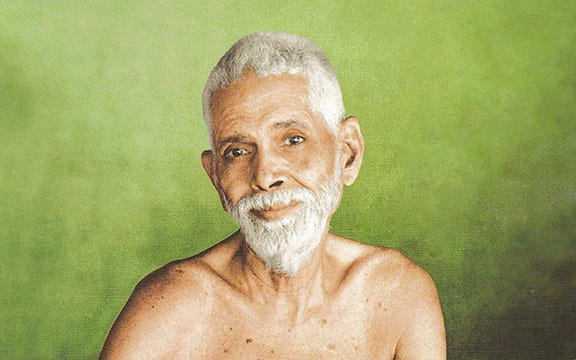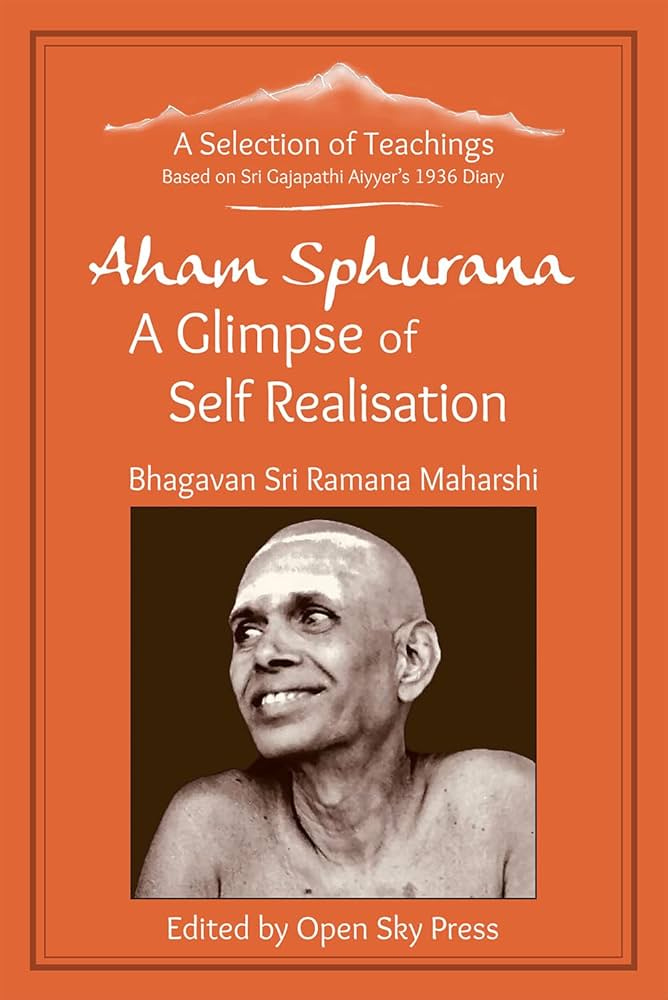Ramana Maharshi of India, the Saint of Non-Duality. A book review
Aged 16, Ramana Maharshi (1879–1950) from Tamil Nadu in south India had a profound realisation of the deathless, the fusion of atman and brahman in the midst of experiencing fears of death.
After his awakening, he spent years in a cave at the foot of Mount Arunachala, 814 metres high. Locals from nearby villages and the small city of Tiruvannamalai supported him while he gave teachings pointing to reflection/inquiry, often focussed on the question: Who am I?
Atman refers to an egoless consciousness and Brahman means the Immeasurable or Supreme God. As with the Buddha, Ramana treated I, me and my, conventional self and its identity with mind-body, roles, experiences and views as false, deceptive and illusory. The Buddha only uses the concept ‘self’ in a conventional way not as the Supreme.
A beautifully published book, Aham Sphurana, A Glimpse of Self-Realisation consists of selections of a 1000-page manuscript written between July and December 1936. The diaries records dialogues of Ramana with devotees in the small hall in the Ramana ashram built up around him. Publishers used the Sanskrit title of the book (I-Pulsation) with around 24 black and white photos from the 1930s.
Based in Germany, Open Sky Press took steps to analyse the MS to ensure the authenticity of the diaries that Sri Gajapathi Aiyyer, a lawyer, had written during his stay in the ashram.
Ramana encouraged his students to keep tracing their experiences and streams of thought to the source, to that before the mind moves, before it comes into formation. Reflection and inner questing of Who am I? points towards the unformed depth to reveal the emptiness of ego and a limitless expanse embracing ‘oneself’ and ‘other.’
I visited Ramana Ashram a few times between 1970s and in the first decade or so of the new millennium, including giving teachings nearby in the latter visits. The ashram welcomed visitors in the 1930s, including Major Chadwick, Ella Maillat and Paul Brunton. See photos. The book reveals many deep questions posed to Ramana on the ultimate truth of things.
Ramana’s Way of Teaching
Throughout his teaching, Ramana showed himself to be a man of few words, with the meeting hall revealing a palpable silence. Visitors can still feel this noble silence in the hall today. Questions were brief and to the point, mostly related to transcendence. Ramana abided in the silence and then responded in a word, a sentence or a few sentences. This followed with a return to the silence before another question or sequence of them arose.
Before embarking on the book, I invite readers to go first to the Glossary (page 273 – page 280) to read the definitions of the Sanskrit words, as the editor has used these words throughout the book. The word Bhagavan is not in the glossary.
Sri Gajapathi put his first question in July 1936.
Here are examples:
Q: Is a Realised Master necessary for realisation? (Page 15)
B: (Bhagavan refers to Ramana. It means God, Ultimate Reality, Holy One). Realisation is the result of Guru’s Grace, more than teachings, lectures, meditation et cetera. They are only secondary aids, whereas the former is the primary and the essential cause.
Q. Yet, I have heard it said you had no Guru (teacher).
B. (Laughing). Yes, but in the majority of cases, Guru is certainly necessary.
Q. How do I attain a Self (egoless Consciousness)?
B. Summa Iru. Be still. That is the practice.
Q. How to recognise Aham Sphurana when it flashes?
B. You will know it alright. Aham Sphurana is a direct experience of the Self.
Readers need to note that Aham Sphurana also means in Sanskrit I-vibration. The vibration reveals through it the truth of Atman-Brahman.
Q. How does one get rid of these hindrances? (Page 33)
B. Seek the Self through meditation in this manner: trace every thought back to the point of origin – the mind’s essence of pure consciousness again and again. Thought and thinker will both die of inaction eventually.
More Quotes from the Text
Q. If Advaita is the only truth, then why did Madvacharya talk about Dvaita (duality) Page 40 and 41.
B. It may be better to ask him.
Q. But he is dead.
B. So am I.
Q. From a Tamil pandit (learned scholar). Your Self-realization in a few words.
B. I came. I saw. I was conquered.
Q. The summit of all knowledge?
B. Absence of all (objective) knowledge.
Q. The king of all virtues?
B. Compassion
Q. The eternal misery?
B. Want.
Q. The true nature of God?
B. Love.
Q. Surely the basic requirements of bodily sustenance – food, water, clothes, a modest roof over one’s head – surely these can be considered reasonable?
B. Do not think they are your requirements. They are the body’s.
Q. Ignoring a problem is no way to solve it.
B. Nor is thinking about it. Carefully study the problem in accompaniment with the associated circumstances. Keep the mind acquiescent in the shining of the heart. The solution springs forth uninvited.
Readers can sense after a while a direct, uncompromising teaching coming out of the stillness, out of the silence.
I found the use of Aham Sphurana as part of the title of the book an odd choice. Few readers know Sanskrit who might be attracted to the book. Ramana teaches full realisation, not a glimpse.
On page 89, Ramana tells a story from the Mahabharata, which he goes onto explain with a long-winded scientific hypothesis running to about four pages, referring to science, sub-atomic particles and laws of Bohr and Heisenberg.
Here is an extract of 30 words: Take a particle that is observed or detected or measured as a certain specific location. Thus, the probability of its being detected in any other place suddenly becomes zero…
Abstract, theoretical and heady. To put it mildly. Perhaps it is an extract from a Western book on science that got entered mistakenly in the diary.
In the books of Ramana’s dialogues with students, I have never seen him veer away from pointing to the essence of Atman. He never encouraged indulgence in conceptual views, via scientific speculation. There are other examples elsewhere, such as a conceptual reference to Jesus (page 77), written in academic language.
Although widely used in Advaita, the word ‘self’ barely reflects the meaning of the word atman. In English, we use ‘self interchangeably with ego, I, me and my, personal self. Sanskrit uses a different word for these concepts – ahamkara. Ahamkara means I-doing, I-making, ego-forming including grasping onto body-mind as I, me or mine.
Atman abides free from ahamkara and all mental products.
Q. Why is everyone calling you Maharishi (Great Sage) or Bhagwan. Have you grown a horn like a rhinoceros on your head?
B. (laughing) I am as clueless as you are.
Q. How to be the Self? The self seems to be like the carrot dangled in front of the foolish mule. – very close yet altogether unattainable. (Page 96)
B. You (as the personal self) are sitting on top of the Self (the Real). Get up and clear off. That will do.
Ramana Maharshi’s approach was notable for its simplicity and directness—he emphasised inner experience over ritual, scripture, or intellectual debate.
The beauty of Ramana’s teachings shows in the unwavering directness with a remarkable clarity and simplicity.
Some Advaitins (Non-Dualists) claim that Ramana did not teach any practice because practice means a duality – a path to get to a goal. They believe Ramana only taught pure Advaita. Those who hold to such a view often state everything is perfect, and there is nothing to be done. This view of conventional reality is nonsense bearing no significance in Advaita teachings.
Sanskrit word for practice is abhyasa. Ramana speaks of the importance of abhyasa regularly in his teachings.
Q. What is the point of me making any efforts at all to realise the Self? (Page 208)
B. The ego might manufacture all sorts of ways to keep you away from abhyasa. Do not believe these deceptive ideas fabricated by the ego. Incessantly go on with your perseverance and determination in your efforts to realise and one day the Self shall reveal…Rome was not built in a day.
Final Word
An excellent book suitable for anyone serious about the spiritual life and committed to knowing profound and liberating realisations. Meditate on the questions and responses. Listen inwardly beneath the mind’s activity.




Thanks for bringing my attention to this book.
I quickly also found "The Aham Sphurana Hoax" by Áine Keenan, and read that short piece first. I think it saved me alot of time, if I would have ever got around to reading the work anyway, my reading list being too long and not at all tackled systematically.
Be well and happy CT, enjoying your presence and musings always
Thank you Christopher for this beautiful review of this important publication. Reading the dialogues with Ramana, my heart sings in jubilation. There is a second volume of excerpts from the original Aham Sphurana manuscript, published by the same group, titled "Vichara - Self Enquiry", which has more illuminating dialogues with Ramana Maharshi.